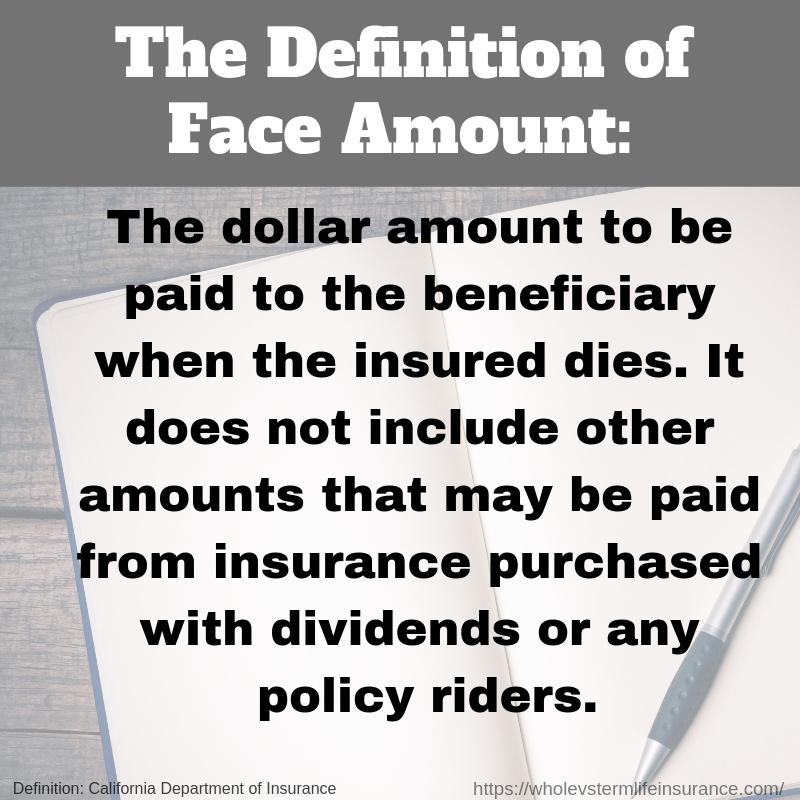Definition of Face Amount of Life Insurance
The face amount of a life insurance policy represents the maximum amount that the insurance company will pay to the beneficiary upon the insured person’s death. It is the primary benefit that the policyholder is covered for.
For example, if you purchase a life insurance policy with a face amount of $500,000, your beneficiary will receive $500,000 upon your death. This amount can be used to cover funeral expenses, pay off debts, or provide financial support for your loved ones.
Face Amount and Premiums
The face amount of a life insurance policy is directly related to the premiums that you pay. The higher the face amount, the higher the premiums will be. This is because the insurance company assumes a greater risk when insuring you for a larger amount.
Factors Affecting Face Amount

The face amount of a life insurance policy is influenced by various factors. Understanding these factors is crucial for determining the appropriate amount of coverage that aligns with an individual’s financial needs and goals.
Income and Future Earnings Potential
One of the primary factors affecting the face amount is an individual’s income and earning potential. A higher income typically translates into a greater need for life insurance coverage. This is because a higher income often means a higher standard of living and financial obligations, such as a mortgage, car payments, and family support. In case of the policyholder’s untimely demise, a sufficient face amount can ensure that these obligations are met, and the family’s financial stability is maintained.
Age and Health Status
Age and health status also play a significant role in determining the face amount. Younger and healthier individuals typically qualify for lower premiums and higher face amounts. As an individual ages or develops health conditions, the cost of insurance increases, and the face amount may need to be adjusted to maintain the desired level of coverage.
Family Responsibilities and Dependents
The number and age of dependents, such as a spouse, children, or elderly parents, can also impact the face amount. A policyholder with a larger family or younger dependents may require a higher face amount to ensure their financial security in the event of the policyholder’s passing.
Debt and Assets
Outstanding debts and the value of assets can also influence the face amount. Individuals with significant debts or limited assets may need a higher face amount to cover potential financial liabilities and ensure that their debts are paid off and their assets are protected.
Lifestyle and Personal Goals
Lifestyle choices and personal goals can also affect the face amount. Individuals with hobbies or activities that involve higher risks may need a higher face amount to provide financial protection in case of an accident or injury. Additionally, those with long-term financial goals, such as retirement or education funding, may want to consider a higher face amount to supplement their savings and ensure their goals are met.
Considerations for Determining Face Amount
Determining the appropriate face amount for your life insurance policy is crucial. Consider your current financial obligations, such as mortgage, debts, and expenses. Assess your future needs, including retirement, education for dependents, and unexpected events.
Assessing Financial Obligations
Evaluate your current liabilities and expenses. Consider your mortgage, car payments, credit card debt, and other loans. Calculate the total amount of outstanding debt you would leave behind in case of your untimely demise. This amount should be covered by your life insurance policy to prevent financial hardship for your loved ones.
Future Needs and Goals
Consider your long-term financial goals and responsibilities. Estimate the cost of your children’s education, retirement expenses, and any potential medical expenses. Ensure that your life insurance policy provides sufficient coverage to meet these future needs, ensuring financial security for your family.
Strategies for Maximizing Face Amount
Individuals can employ various strategies to maximize the face amount of their life insurance policy while considering affordability. These strategies involve assessing financial needs, understanding policy types, and leveraging available options. It’s crucial to weigh the potential benefits and drawbacks of each approach to make informed decisions.
Policy Type Selection
Selecting a suitable policy type can significantly impact the face amount. Term life insurance offers lower premiums and higher coverage for a specified period, making it ideal for temporary coverage needs. Whole life insurance provides lifelong coverage and accumulates cash value over time, but premiums are typically higher. Universal life insurance combines features of both term and whole life, offering flexibility in premium payments and death benefits. Understanding the differences and choosing the policy type that aligns with financial goals is essential.
Rider Add-Ons
Riders are optional additions to a life insurance policy that can increase the face amount. Some common riders include accidental death benefit riders, which provide additional coverage in the event of accidental death, and waiver of premium riders, which waive future premium payments if the insured becomes disabled. Adding riders can enhance coverage but may also increase premiums.
Multiple Policies
Purchasing multiple life insurance policies can also maximize face amount. This strategy involves spreading coverage across different policies, each with its own face amount. It can be beneficial for individuals with substantial coverage needs or those who want to diversify their coverage options. However, managing multiple policies may require careful monitoring and coordination.
Regular Policy Reviews
Regularly reviewing and adjusting life insurance policies is crucial to ensure adequate coverage. As financial circumstances and life stages change, the face amount may need to be adjusted to reflect changing needs. Reviewing policies periodically allows individuals to assess whether their coverage is still sufficient and make necessary adjustments.




